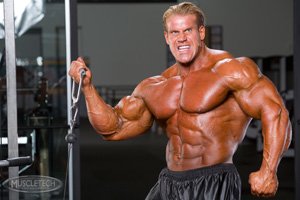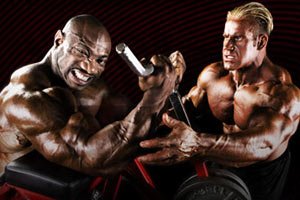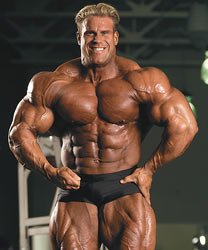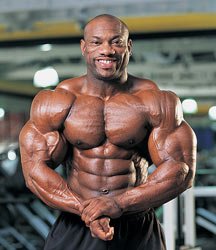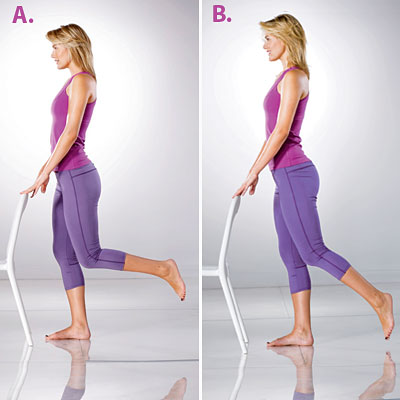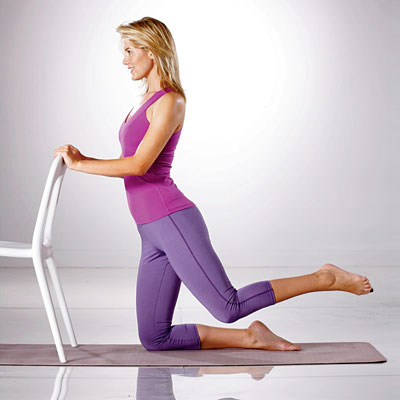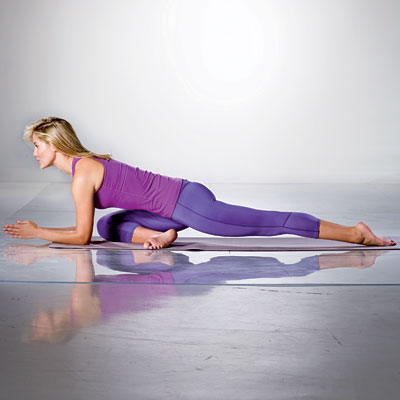"WARM MARBLE" The Lethal Physique of Bruce Lee
By John Little
Introduction by Mike Mentzer
It is absolutely amazing how much of an impact that Bruce Lee's strength and physical development have had on athletes, bodybuilders and average men all over the face of the globe. As a young boy in high school, I can clearly recall all of the talk among my friends about the great Bruce Lee; they all were intimately familiar with Bruce's films; and they would discuss not just his epochal martial arts skills, but, also, his incredible strength and lean, shredded physique.
 As Mr. Little reports in his article, even such a personage as Joe Weider remarked on the astounding muscular refinement and definition of Lee's physique, especially the master's abs. As Mr. Little also explains, Bruce Lee's physique had a remarkable influence on some of today's top physique champs. Bodybuilding luminaries, including Lou Ferrigno, Lee Haney, Dorian Yates, Rachel Mclish, Lenda Murray, Flex Wheeler and Shawn Ray have all spoken on record concerning the enormous impact the physique of Bruce Lee had on them. Why? Why would the physique of the mighty mite, never massively developed along the lines of the bodybuilding greats I just enumerated, but described by some "as the most defined physique in the world." I leave that unanswered, as author, John Little, will provide an incisive, eloquent answer...
As Mr. Little reports in his article, even such a personage as Joe Weider remarked on the astounding muscular refinement and definition of Lee's physique, especially the master's abs. As Mr. Little also explains, Bruce Lee's physique had a remarkable influence on some of today's top physique champs. Bodybuilding luminaries, including Lou Ferrigno, Lee Haney, Dorian Yates, Rachel Mclish, Lenda Murray, Flex Wheeler and Shawn Ray have all spoken on record concerning the enormous impact the physique of Bruce Lee had on them. Why? Why would the physique of the mighty mite, never massively developed along the lines of the bodybuilding greats I just enumerated, but described by some "as the most defined physique in the world." I leave that unanswered, as author, John Little, will provide an incisive, eloquent answer...
Subsections in the article will titillate the legion of existing Lee fanatics, and whet the appetite of those for whom this article will serve as their initial introduction to the subject. For instance, Functional Strength, Unbelievable Strength, A Battle in San Fransisco, The Bodybuilding Connection and The Routine, will rivet the reader's focus such that he will finish this article in one reading, and prompt him to want to re-read it and re-re-read it.
I've been extremely impressed over the years as to how many bodybuilders are also highly trained martial artists. In fact, over the years I having personally supervised the training of many martial artists, with many of my phone clients already being rabid Lee fans, and martial artists seeking the most efficient manner of training for strength and speed; which was the goal of Lee's training. Also, I receive more e-mails, letters and phone calls from martial artists than any other type of athlete. This I believe follows from Lee's well known concern with weight training to develop efficiency and strength.
I am extremely proud to say that one of my best friends, for the past 22 years, wrote this article, which is excerpted from one of the 11 books he's written on Bruce Lee. I first met John Little at Eaton's department store in Toronto where Arnold, Franco and I had made an appearance for Weider and the IFBB, in 1979. We hit it off immediately, as John was philosophically oriented, along with having a passionate interest in bodybuilding. After that initial meeting, we met at Lou Hollozi's gym in Toronto in 1980, where I conducted a seminar; and, with that, John and I further cemented our friendship. Subsequently, John made a number of trips to Los Angeles, where he'd usually stay with me in my apartment in West Hollywood. His primary purpose in traveling to southern California was to pursue the subjects of those he wrote books about, including Steve Reeves and Lou Ferrigno.
It was finally, in 1992, that Joe Weider brought John to Los Angeles to write for Flex. This only lasted three years, as John was more interested in writing freely about his passion, namely - philosophy, martial arts, the philosophy of Bruce Lee's, who, too, was a fervent student of philosophy, his personal library packed with philosophy books that extended from the floor to the ceiling and spanned the length of the room. His quest for the truth saw him avidly studying philosophies ranging from that of Krishnamurti's to our most revered, Ayn Rand.
Bruce Lee's life was most interesting as he rose from a starving, poor boy in Hong Kong to the world's most celebrated movie star in Hollywood, having a greater impact on more people than that of Elvis Presley's, James Dean's and Marilyn Monroe's combined!
I trust that you, dear reader, will gain much knowledge from John Little's article, along with the added inspiration that will act to have you approach your own training with greater inspiration and motivation than ever before. Above all else, I ardently desire that you will read John Little's superlative article mostly for the sheer pleasure of it.
Mike Mentzer
"If you're talking about combat -- as it is -- well then, baby you'd better train every part of your body!" -- Bruce Lee (from the video, Bruce Lee: The Lost Interview)
There's an anecdote that has endured some 28 years concerning the texture of the muscles that adorned the physique of the late martial arts pioneer/philosopher, Bruce Lee.
It concerns a lady named Ann Clouse, the wife of Robert Clouse, the man who directed Lee's last film Enter the Dragon for Warner Bros. It seems that Clouse's wife had ventured onto the set of the film and was mesmerized by Lee's incredible physique as he went through his paces choreographing the fight scenes for the film, stripped to the waist under the hot and humid Hong Kong sun. In between takes, Ann approached the young superstar and asked if she could "feel his biceps." "Sure," Lee responded -- it was a request he'd received on numerous occasions -- tensing his arm and inviting her to check it out for herself. "My God!" she exclaimed, drawing her hand back instantly, "It's like feeling warm marble!"
 It's fascinating that almost three decades later, people are still talking about the body of Bruce Lee -- although it is by no means surprising. The Lee physique, once described by no less an authority on such matters than bodybuilding magnate Joe Weider as "the most defined body I've ever seen!" has attracted (much like the man's martial art and philosophy) a following that not only rivals but exceeds those of Elvis Presley, James Dean and Marilyn Monroe -- combined! Certainly his following exceeds that of any bodybuilder of a similar vintage. And even more fascinating is the fact that almost everyone gets something different out of Bruce Lee -- martial artists revere his physical dexterity, power, speed and the genius he displayed in bringing science to bear on the world of martial arts; moviegoers are impressed with the man's screen presence and animal magnetism, along with the fact that he single-handedly created a new genre of action film thus opening the door to the Stallones, Schwarzeneggers and Jackie Chans who were to follow in his footsteps; philosophers are impressed with Lee's ability to bridge the philosophical chasm separating East and the West and to synthesize the best aspects of both cultures. But there exists another pocket of humanity that sees in Lee something else -- although not entirely unrelated -- the bodybuilders. Bodybuilders, young and old, know from one quick glance at Lee's physique exactly how much labor went into its creation -- and they are, one and all, very impressed.
It's fascinating that almost three decades later, people are still talking about the body of Bruce Lee -- although it is by no means surprising. The Lee physique, once described by no less an authority on such matters than bodybuilding magnate Joe Weider as "the most defined body I've ever seen!" has attracted (much like the man's martial art and philosophy) a following that not only rivals but exceeds those of Elvis Presley, James Dean and Marilyn Monroe -- combined! Certainly his following exceeds that of any bodybuilder of a similar vintage. And even more fascinating is the fact that almost everyone gets something different out of Bruce Lee -- martial artists revere his physical dexterity, power, speed and the genius he displayed in bringing science to bear on the world of martial arts; moviegoers are impressed with the man's screen presence and animal magnetism, along with the fact that he single-handedly created a new genre of action film thus opening the door to the Stallones, Schwarzeneggers and Jackie Chans who were to follow in his footsteps; philosophers are impressed with Lee's ability to bridge the philosophical chasm separating East and the West and to synthesize the best aspects of both cultures. But there exists another pocket of humanity that sees in Lee something else -- although not entirely unrelated -- the bodybuilders. Bodybuilders, young and old, know from one quick glance at Lee's physique exactly how much labor went into its creation -- and they are, one and all, very impressed.
Ironically, bodybuilding luminaries of no less stature than Flex Wheeler, Shawn Ray, Rachel McClish, Lou Ferrigno, Lee Haney, Lenda Murray and former Mr. Olympia, Dorian Yates -- that is to say, the best in the business - have all spoken on the record regarding the impact the physique of Bruce Lee had on their bodybuilding careers. "How could this be?" I can hear you ask, perhaps somewhat incredulously. After all, Lee was only 5'7" tall and checked in at a weight that fluctuated between 126 to 145 pounds! What could a behemoth like Dorian Yates, for example, see in Bruce Lee's physique that would give him grounds for any form of inspiration? The answer, in a word, would be quality.
There has seldom been seen - this side of a jungle cat -- the incredible sinewy and ripped-to-the-bone quality of muscle displayed by Bruce Lee. He was ripped in places that bodybuilders are just now (28 years later) learning they can train. Every muscle group on his body stood out in bold relief from its neighbor -- not simply for show (unlike many bodybuilders) but for function. Lee was, to quote his first student in the United States, Seattle's Jesse Glover, "above all else, concerned with function." Lee's body was not only a thing of immense grace and beauty to watch in action, but it was supremely functional. Leaping eight feet in the air to kick out a light bulb (as evidenced in Lee's office-wrecking scene in the MGM movie Marlow), landing a punch from five feet away in five-hundredths of a second and catching grains of rice -- that he'd thrown into the air -- with chopsticks were things Lee had trained his body (and reflexes) to accomplish. In fact, during his famous "Lost Interview" Lee referred to his approach to training as "the art of expressing the human body." Indeed, perhaps never before has there been such an incredible confluence of physical attributes brought together in the form of one human being -- lightening fast reflexes, supreme flexibility, awesome power, feline grace and muscularity combined in one total -- and very lethal -- package.
Furthermore, the Lee physique was balanced and symmetrical and, while not everyone can be said to admire the massive musculature of our Olympians, everyone -- or so it would seem (including the world's greatest bodybuilders) admire the "total package" that was Bruce Lee.

Who should have won? Judge for yourself.
|
All of the aforementioned champion bodybuilders have indicated that Bruce Lee was a major influence on their bodybuilding careers, which is no small accomplishment when one considers the fact that Lee never entered a physique contest in his life. Ironically, despite his influence being, felt by the hardest of hard-core bodybuilders, Lee himself was never interested in developing a massive musculature. One of Lee's closest friends and an instructor in Lee's art of Jeet Kune Do, Ted Wong, recalls that "Bruce trained primarily for strength and speed." The physique -- while certainly appreciated by Lee -- came almost as a by-product of such training. According to those who met him, from Hollywood producers to his fellow martial artists, Lee's muscles carried considerable impact. Taky Kimura, one of Lee's closest friends (in fact, the best man at Lee's wedding in 1964) recalls that Lee was never loath to remove his shirt and display the results of his labors in the gym -- often just to see the reactions of those around him. "He had the most incredible set of lats I'd ever seen," recalled Kimura, "and his big joke was to pretend that his thumb was an air hose, which he'd then put in his mouth and pretend to inflate his lats with. He looked like a damn cobra when he did that!"
Lee's physique holds up under scrutiny and has survived the passage of time simply because it possessed what many consider to have been the perfect blend of razor-sharp cuts, awesome muscularity, great shape and an almost onion skin definition. The muscles that bulged and rippled across the Lee physique were thick, dense, well-chiseled from their neighbor and, above all, functional.
Functional Strength
Dan Inosanto, another of Lee's close friends and himself an instructor in Lee's art, adds that Lee was only interested in strength that could readily be converted to power. "I remember once Bruce and I were walking along the beach in Santa Monica, out by where the 'Dungeon' (an old-time bodybuilding gym) used to be," recalls Inosanto, "when all of a sudden this big, huge bodybuilder came walking out of the Dungeon and I said to Bruce, 'Man, look at the arms on that guy!' I'll never forget Bruce's reaction, he said 'Yeah, he's big -- but is he powerful? Can he use that extra muscle efficiently?"
Power, according to Lee, lay in an individual's ability to use the strength developed in the gym quickly and efficiently; in other words, power was the measure of how quickly and effectively one could summon and coordinate strength for "real-world" purposes. On this basis, according to those who worked out with Lee from time to time such as martial arts actor Chuck Norris, Bruce Lee -- pound for pound-- might well have been one of the most powerful men in the world.
 Unbelievable Strength
Unbelievable Strength
Lee's feats of strength are the stuff of legend; from performing push-ups - on one hand! - or thumbs only pushups, to supporting a 125-pound barbell at arms length in front of him (with elbows locked) for several seconds, or sending individuals (who outweighed him by as much as 100 pounds in some instances) flying through the air and landing some 15 feet away as a result of a punch that Lee delivered from only one-inch away, the power that Bruce Lee could generate -- at a mere bodyweight of 135 pounds -- is absolutely frightening. Not to mention some of his other nifty little habits like thrusting his fingers through full cans of Coca-Cola and sending 300 pound heavy bags slapping against the ceiling with a simple side kick.
Strength training -- qua strength training -- was Lee's primary objective with resistance exercise. Later, as we shall soon see, his training evolved into more specialized applications that were beneficial to his specific goals as a martial artist. But before we get to there, let's first take a look at how Lee was first drawn to bodybuilding.
Ideals & Possibilities
For a number of years, Lee had made a concerted study of exercise physiology and anatomy. Refusing to merely accept tradition for tradition's sake - a stance that made him increasingly unpopular with the majority of his fellow martial artists who had been raised and were now in the process of passing on (without questioning) the various martial traditions of the East -- Lee's background in physiology and kinesiology had imbued him with the ability to discern a useful exercise from an unproductive one and therefore he was able to avoid the obstacle of wasted time in any of his workouts. Lee believed that the student of exercise science should aim at nothing less than physical perfection, with all that it implies in its totality; he should want great strength, great speed, great coordination, exuberant health, and, by no means least, the muscular beauty of form which distinguishes a physically perfect human being. To Lee, the whole secret of success in bodybuilding lay in the principle of progressive resistance, but he also recognized that there was another component that had won a place in the vocabulary of physical culture and that word was persistence.
Certainly Lee was nothing if not persistent in his quest to fully explore and express the potential of his body, a physique that not only looked phenomenal on a movie screen but that also possessed a musculature that was geared for function. Given the physiological fact that a stronger muscle is a bigger muscle, it was only natural that Lee would in time come to appreciate the superior health-building benefits of bodybuilding -- but I'm getting ahead of myself.
Let us now examine the situation that first caused Lee to appreciate bodybuilding and then we shall focus on what routine he utilized to build the muscles that served him with such tremendous efficiency. While Lee may have been aware of the general benefits to be had from a program of progressive bodybuilding exercises, it took a violent encounter to make him fully cognizant of the merits that a more regular and dedicated approach to bodybuilding could provide.
A Battle in San Francisco
One evening while Lee was preparing to teach a class to a group of select students in his modest San Francisco kwoon (kung fu school), the door to his school suddenly flew open and in walked a group of Chinese martial artists led by a practitioner who was considered to be their best fighter and the designated leader of the troupe. According to Lee's wife, Linda, who was both present and eight months pregnant with the couple's first child, Brandon, at the time, Lee had on a prior occasion been served with an ornate scroll saying in bold Chinese characters that he had an ultimatum: stop teaching non-Chinese students Gung fu (the Cantonese pronunciation of Kung Fu) or be prepared to fight with San Francisco's top Kung Fu man. Now, the day of reckoning had come.
Lee handed the scroll disdainfully back to their leader. "I'll teach whomever I choose," he said calmly. "I don't care what color they are." While Lee's non-racist views are today generally applauded, in San Francisco's Chinatown in the mid 1960s they were tantamount to treason -- at least within the Chinese community. Indeed, teaching Chinese combative "secrets" to non-Chinese races was perceived as the highest form of treason in the martial arts community. By his words and demeanor, Lee had effectively thrown the gauntlet back at the feet of his would-be challenger and, while Lee had many virtues, it is well known among his friends, family and students that patience in suffering fools and their ignorance was not one of them.
A fight immediately broke out and, in a matter of seconds, Lee had the previously bold and self-righteous kung fu "expert" running for the nearest exit. Finally, after much legwork, Lee was able to throw his man to the floor and extract a submission from him. In a rage, Lee threw the entire troupe off the premises, cursing them out in Cantonese, en route. However, Lee quickly learned -- to his shock, given that the fight had lasted all of three minutes -- that he had expended a tremendous amount of energy in the altercation. "He was surprised and disappointed at the physical condition he was in," recalled Linda of the occasion. "He'd thought that the fight had lasted way too long and that it was his own lack of proper conditioning that made it such a lengthy set-to. He had felt inordinately winded afterwards."
It was this fight more than any other single event that had given Lee sufficient cause to thoroughly investigate alternate avenues of physical conditioning. His conclusion? He would need to develop considerably more strength -- of both his muscles and cardiovascular system -- if he was ever to become the complete martial artist he had envisioned becoming.
The Bodybuilding Connection
Knowing that the muscle magazines were the only existing source of current health and strength training information, Lee immediately began to subscribe to all of the bodybuilding publications he could find. He ordered bodybuilding courses out of the magazines and tested their claims and theories. He made a habit out of frequenting second-hand bookstores and purchasing books on bodybuilding and strength training, including one written by Eugene Sandow entitled Strength & How to Obtain It -- which was originally published in 1897. Lee's hunger for knowledge in the field of bodybuilding ran so high, that he purchased everything he could get his hands on -- from "hot off the press" courses to back list classics. No price was too high for knowledge, particularly if its application resulted in the acquisition of greater bodily strength, power and physical efficiency.
From this point on until his eventual death in July of 1973 (of a cerebral edema), Bruce Lee amassed a tremendous personal library of books on philosophy, martial art and an extensive selection of tomes that dealt extensively with physical fitness, bodybuilding, physiology and weight lifting. Lee would underline certain passages of text that he found particularly meaningful and would constantly jot down thoughts of how this information could be applied to martial art in the margins of the books. "Bruce used to come into his school in L.A.'s Chinatown with an armful of articles from the muscle magazines," recalls Inosanto. "He'd say 'look at this: these bodybuilders all say that they do this in order to increase their strength -- it's a common denominator running throughout all of their writings.' He'd look for consistency in things like that and would compare and eliminate the additional data that he felt was superfluous."
The Routine
After much research, and with the help of two bodybuilders who were also his close friends and students in the San Francisco Bay area, Lee devised a three-day-per-week bodybuilding program that he felt fit his strengthening and bodybuilding needs perfectly. According to one of these men, Allen Joe, "James Lee and I introduced Bruce to the basic weight training techniques. We used to train with basic exercises like squats, pullovers and curls for about three sets each. Nothing really spectacular but we were just getting him started." This program actually served Lee well from 1965 through until 1970 and fit in perfectly with Lee's own philosophy of getting the maximum results out of the minimum -- or most economical -- expenditure of energy.
The every-other-day workout allowed for the often neglected aspect of recovery to take place. Lee coordinated his bodybuilding workouts in such a way so as to insure that they fell on days when he wasn't engaged in either endurance-enhancing or overly strenuous martial art training. The program worked like magic; increasing Lee's bodyweight from an initial 130 pounds to -- at one point -- topping out at just over 165 pounds!
According to Glover, however, Lee wasn't particularly pleased with the added mass; "I noticed that he was bigger after he was weight training. There was a time after he went to California that he went up to 165 pounds. But I think it slowed him down because that was real heavy for Bruce. He looked buff like a bodybuilder. And then, later on I saw him and this was all gone. I mean, one thing that Bruce was [about] was function -- and if stuff got in the way, then it had to go. Bruce wanted his weight training to complement what he did in the martial arts. A lot of what Bruce was doing was about being able to maintain arm positions that nobody could violate in a fight. Like, if you take most people who are into bodybuilding or weight training, most of them are interested in simply building up their muscles to a bigger size, particularly the major muscle groups -- not much attention is paid to the connective tissues, like ligament and tendon strength. Well, Bruce's thing was 'let's build up the connectors and we won't worry so much about the size of the muscle.' Again, Bruce was about function."
Gearing his training for function, Lee's bodybuilding routine incorporated the three core tenets of total fitness- stretching for flexibility, weight training for strength and cardiovascular activity for his respiratory system -- the original cross-trainer!
Bruce Lee's "Lethal Physique" Bodybuilding Program
(performed on Tuesdays, Thursdays and Saturdays)
| Exercise | Sets | Repetitions |
| Clean & Press | 2 | 8 |
| Squats | 2 | 12 |
| Pullovers | 2 | 8 |
| Bench Presses | 2 | 6 |
| Good Mornings | 2 | 8 |
| Barbell Curls | 2 | 8 |
The Breakdown of the Routine:
1.) Clean & Press: Lee would begin this movement by taking a shoulder-width grip on an Olympic barbell. Bending his knees, he would squat down in front of the resistance and, with a quick snap of his arms and a thrust from his legs, clean the barbell to his chest and stand up. After a brief pause, Lee would then thrust the barbell to arms length overhead, pause briefly, and then lower the barbell back to the top of his chest. After another brief pause, he would lower the barbell back to the floor (the starting position). With absolutely no rest, Lee would then initiate his second repetition of the movement and continue to do so until he had completed eight repetitions. After a very brief rest, so as to take full advantage of the cardio-respiratory benefits as well as the strength-building benefits, Lee would perform a second -- and final -- set.
2.) Squats: This staple of bodybuilding movements was the cornerstone of Bruce Lee's barbell training. He had dozens of articles that he'd clipped out on the mechanics and benefits of squats and he practiced many variations of this exercise. In his routine, however, he performed the exercise in the standard fashion. Resting a barbell across his shoulders, Lee would place his feet approximately shoulder-width apart. Making sure that he was properly balanced, Lee would slowly ascend to a full squat position. With absolutely zero pause in the bottom position, Lee would then immediately return -- using the strength of his hips, glutes, hamstrings, calves and quadriceps -- to the starting position, whereupon he would commence rep number two. Lee would perform 12 repetitions in this movement and, after a short breather, return and re-shoulder the barbell for one more set of 12 reps.
3.) Pullovers: Although there exists no physical evidence that Bruce Lee supersetted barbell pullovers with squats, there is reason to believe that this was case -- if only for the fact that such was the method advocated in the articles he read. Squats were considered a great "overall" muscle builder, whereas pullovers were simply considered a "rib box expander" or "breathing exercise." Consequently, the fashion of incorporating pullovers in the late 1960s and early 1970s was as a "finishing" movement for squats. This being the case, Lee would perform the movement in the standard fashion; i.e., by lying down on his back upon a flat bench and taking a shoulder-width grip on a barbell that he would then proceed to press out to full extension above his chest. From this position, Lee would lower the barbell -- making sure to keep a slight bend in his elbows so as not to strain the elbow joint -- behind his head until it touched the floor ever so slightly and provided a comfortable stretch to his lats. From this fully-extended position, Lee would then slowly reverse the motion through the contraction of his lats, pecs and long-head of the triceps. He would repeat this movement for two sets of eight repetitions.
4.) Bench Presses: Bruce Lee was able to develop an incredible chest musculature. His upper pecs were particularly impressive, bunching and splitting into thousands of fibrous bands. And, as far as his personal training records indicate, the only direct barbell movement he performed to develop his chest was the good old fashioned bench press. Lying down upon a flat bench, and again taking a shoulder-width grip on an Olympic barbell, Lee would press the weight off the support pins to arms length above his chest. From this locked-out position, Lee would then lower the barbell to his chest and, exhaling, press it back up to the fully-locked out (or starting) position. He would repeat this movement for six repetitions and then, after a brief respite, return to the bench for one more set of six reps.
5.) Good Mornings: A word of caution about this exercise. Lee performed this movement to strengthen his lower back. However, one day in early 1970 he loaded up the bar with 135 pounds (his bodyweight at the time) and -- without a warm up -- proceeded to knock off eight repetitions. On his last rep he felt a "pop" and found out later that he had damaged the fourth sacral nerve of his lower back. The result was the Lee had to endure incredible back pain for the remainder of his life. This is not to say that the movement is without merit, just make sure that you perform an adequate warm-up prior to employing, it. Placing a barbell across his shoulders, Lee would place his feet three inches apart (Lee would later confide to Dan Inosanto "You really don't need any weight but the empty bar on your shoulders Dan -- it's more of a limbering movement") and bend over from the waist keeping his hands on the barbell at all times. Lee would bend over until his back was at a 90 degree angle to his hips and then return to the upright position. Lee performed two sets of eight repetitions of this movement.
6.) Barbell Curls: Bruce Lee performed barbell curls not only in his garage gym on Roscomare Avenue in Bel Air, but also in his studio office in Hong Kong. They were a staple or "core" movement in his weight training routine and were also responsible for building a very impressive pair of biceps on Lee -- not to mention incredible pulling power, which he used to such good effect in all of his sparring sessions! To perform this movement properly, Lee would take a comfortable shoulder-width grip on the barbell with his palms facing forwards. Keeping a slight bend in his knees for stabilization purposes, Lee would then contract his biceps and curl the barbell up to a point level with his upper pecs. Pausing briefly in this fully-contracted position, Lee would then slowly lower the barbell back to the starting position. Two sets of eight repetitions of this movement would typically wrap up Lee's bodybuilding routine.

Get Mentzer's
Latest Book
Muscles in Minutes
|
Going Beyond "Routine" According to Inosanto, Lee didn't just train with the above listed exercises. He would also incorporate weight training into his martial art workouts. "Bruce would always shadow box with small weights in his hands and he'd do a drill in which he'd punch for 12 series in a row, 100 punches per series, using a pyramid system of 1,2,3,5,7 and 10-pound weights -- and then he'd reverse the pyramid and go 10, 7, 5, 3, 2, 1 and finally "zero" weight. He had me do this drill with him and -- Man! -- what a burn you'd get in your delts and arms!"
It didn't stop there however. When Lee wasn't training with weights in his martial art workouts or during one of his three designated whole-body training sessions, he could be found curling a dumbbell in the office in his house. "He was always using that dumbbell," recalls Linda in looking back on her husband's training habits. "Bruce had the unique ability to be able to several things at once. It wasn't all unusual for me to find him watching a boxing match on TV, simultaneously performing a full side splits, while reading a book in one hand and pumping a dumbbell in the other."
Incredible Abs
By far the most impressive of all of Lee's bodyparts was his abdominal muscles, which he trained daily. "Bruce always felt that if your stomach wasn't developed, then you had no business sparring," recalls Wong. "He was a fanatic about abdominal training," concurs Linda, "he was always doing sit-ups, crunches, Roman Chair movements, Leg Raises and V-ups." Chuck Norris has gone on record recalling the time that he went to visit the Lee family and seeing Bruce lying on the living room floor bouncing his son Brandon on his abdomen while simultaneously performing dumbbell flyes for his pecs and leg raises for his abs - and watching television to boot!
Forearms of Steel
In order to improve his gripping and punching power, Lee became an avid devotee of forearm training, While many champion bodybuilders shy away from direct forearm training, Lee made it a point to train his forearms daily. "He was a forearm fanatic," laughs Linda in retrospect. "If ever any bodybuilder -- such as Bill Pearl -- came out with a forearm course, Bruce would have to get it." Bruce even commissioned an old friend of his from San Francisco, George Lee (no relation) to build him several "Gripping machines" to which Lee would add weight for additional resistance. "He used to send me all of these designs for exercise equipment," recalls George Lee, "and I'd build them according to his specs. However, I wasn't altogether foolish," he says with a laugh, "I knew that if Bruce was going to use it, it must be effective, so I'd build one to send to him and another for me to use at home!"
Allen Joe recalls that Lee had a favorite dumbbell exercise that he used to train his forearms with constantly: "Bruce was always working on his forearms. He'd pick up a weight and go to the edge of the sofa and start doing wrist curls while he was watching TV. Then he'd do his abdominal work -- and then he'd return to his forearm training. The dumbbell curl he liked best was a Zottman curl, where you would curl the weight up one side of your body and then you twist it and bring it down on the other side. He'd do that all the time!"
Knowledge Is Power
For the past seven years I've been hard at work compiling all (and I mean ALL) of Bruce Lee's training programs, notes and annotations on physical training for a book series that, like Lee's training methods, has proved to be constantly evolving (the training material has been presented in the book entitled The Art of Expressing The Human Body, Tuttle Publishing, Boston). And what amazes me after having looked through all of his materials is just how thorough his knowledge of training actually was. Lee collected over 140 books on bodybuilding, weight training, physiology and kinesiology during his lifetime, in addition to well over 2,000 books on philosophy and the martial arts. Lee believed that you could never know "too much" about a subject that could benefit your health and he lived his entire life trying to acquire as much knowledge about health and fitness as he could.
Although Lee is no longer with us, his teachings and his example live on. Certainly this is so in the realm of exercise science. Lee epitomized the athletic ideals of diligence, hard work, bearing up under adversity and refusing to short-change either oneself or one's potential. "Low aim is the biggest crime a man can commit," he once told Tae Kwon Do Master, Jhoon Rhee. "Remember, Life is a journey, not a destination."
The Roman philosopher Seneca once said that, "Life, if thou knowest how to use it, is long enough." If this is so, then Bruce Lee's life was long enough to be a fulfilling one, perhaps - given what he accomplished and the enduring influence of his example -- it might just be considered one of the more meaningful lives of the twentieth century. And it was Lee's commitment to excellence - and to a principled approach to training - that resulted in the creation of one of the greatest physiques in modern history.
*** *** ***


